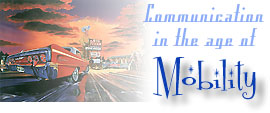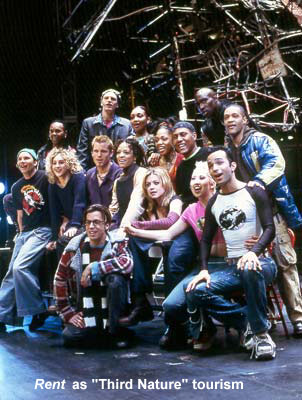
Office: HGH 210; phone: (408) 924-5378
Email: wooda@email.sjsu.edu
Web: http://www.sjsu.edu/faculty/wooda
 |
Dr. Andrew Wood Office: HGH 210; phone: (408) 924-5378 Email: wooda@email.sjsu.edu Web: http://www.sjsu.edu/faculty/wooda |
Introduction
: Course Calendar : Policies
: Readings
Assignments : Check Your Grades : Return
to Frontpage
Reading: Rothman, H.K. (1998). Devil’s bargains: Tourism in the twentieth-century American West. Lawrence, KS: University Press of Kansas.
Study guide: Focus on (1) best example of postmodern tourism, (2) three kinds of nature, (3) three types of tourism, (4) hierarchy of communities, (5) first rail line specifically to a tourist destination.
 In
his introduction to Devil's Bargains (pp. 10-28 and 29-49), Hal K. Rothman
defines his title as a paradoxical relationship between tourists and the places
they visit. The process of transformation from place to commodity results in
the destruction of whatever originally brought people to this locale: "Typically
founded by resident protoentrepreneurs, the industry expands beyond local control,
becomes institutionalized by large-scale forces of capital, and then grows to
mirror not the values of the place but those of the traveling public" (p.
16). The devil's bargain accepted to create the "American West" earns close
study as an exemplar of this phenomenon because of its significance as an icon
of U.S. culture: "Western tourism stands at the heart of the American drama
precisely because it occurs on the same stage as the national drama of self-affirmation.
To Americans the West is their refuge, the home of the last best place"
(p. 15, emphasis added). Even the contemporary popularity of Route
66 may be explained by this drama.
In
his introduction to Devil's Bargains (pp. 10-28 and 29-49), Hal K. Rothman
defines his title as a paradoxical relationship between tourists and the places
they visit. The process of transformation from place to commodity results in
the destruction of whatever originally brought people to this locale: "Typically
founded by resident protoentrepreneurs, the industry expands beyond local control,
becomes institutionalized by large-scale forces of capital, and then grows to
mirror not the values of the place but those of the traveling public" (p.
16). The devil's bargain accepted to create the "American West" earns close
study as an exemplar of this phenomenon because of its significance as an icon
of U.S. culture: "Western tourism stands at the heart of the American drama
precisely because it occurs on the same stage as the national drama of self-affirmation.
To Americans the West is their refuge, the home of the last best place"
(p. 15, emphasis added). Even the contemporary popularity of Route
66 may be explained by this drama.
In his introduction, Rothman describes tourism as a process through which locals transform themselves, marketing their identities to accommodate the expectations of their visitors/consumers: "Tourist workers quickly learn that one of the most essential traits of their service is to mirror onto the guest what that visitor wants from them and from their place in a way that affirms the visitor's self image" (p. 12). The manner in which local behavior and architecture are scripted creates an illusion whereby visitors believe that are both at the center of reality in a tourist place, even as they seek to be "one of the locals." The transition from experience to simulation emerges in a tripartite process borrowed from William Cronon: first, second, and third nature. First nature is the world of the garden; it contains human beings living in the world, organically related to its natural cycles. Second nature is the world of the machine; it is the production of things. Third nature is best illustrated by Disney's California Adventure; it is the postmodern consumption of images. While Rothman defines postmodernity throughout his introduction, a most useful definition is found in his discussion of the contemporary melding of technology, attitude, and style:
 Within
the second nature, one finds two types of tourism in the West. The first, heritage/cultural
tourism, markets an "historic, scenic, and mythic past" as both critique
and affirmation of the industrial age. The second, recreational tourism,
involves a short term, intensive physical experience in the outdoors - a celebration
and rebuke of the industrial age which makes such experience unnecessary.
Third nature is the site of entertainment
tourism. Inspired by media of image manipulation (such as the television
and personal computer), entertainment tourism is postmodern. From this perspective,
the West becomes "a playground, the American dreamscape, historic, mythic, and
actual, spawning a complex industry with the ability to transform places as
it creat[es] an economy for destitute and flourishing communities alike"
(p. 24).
Within
the second nature, one finds two types of tourism in the West. The first, heritage/cultural
tourism, markets an "historic, scenic, and mythic past" as both critique
and affirmation of the industrial age. The second, recreational tourism,
involves a short term, intensive physical experience in the outdoors - a celebration
and rebuke of the industrial age which makes such experience unnecessary.
Third nature is the site of entertainment
tourism. Inspired by media of image manipulation (such as the television
and personal computer), entertainment tourism is postmodern. From this perspective,
the West becomes "a playground, the American dreamscape, historic, mythic, and
actual, spawning a complex industry with the ability to transform places as
it creat[es] an economy for destitute and flourishing communities alike"
(p. 24).
One product of entertainment tourism is the rise of neonatives - newcomers who imitate locals, providing visitors sanitized versions of the people they came to see. A useful illustration of this phenomenon is the process of visiting Times Square in New York City and seeing the play, Rent. In the safety and status of expensive seats, you can experience destitute "locals" - actors from around the world who've gathered to provide a spectacle affirming your expectations of what New York is "really" like.
In his chapter, "Tourism and the framing of culture" (pp 29-49), Rothman, focuses on the American West as prototype of the site in which "the tourist became an actor on the stage of the industrial and postindustrial world, the observer and the observed" (p. 29). Late nineteenth century tourism represents three concepts: the romantic search for the sublime (explored in the Löfgren piece), the Manifest Destiny inspired notion of conquest, and the empiricist search for useful knowledge. Media of representation, technology of conveyance, and myths of re-creation met to fashion the identity of the mythic West, and to transform its geography into iconography.
The key to this transformation, according to Rothman, was the nineteenth century railroad - the symbol of the industrial age. The railroad is remarkable not only for its speed and power to reshape the natural world, but also for its impact on travelers - their transformation into tourists:
Along with its impact on travelers, the railroad played an integral part in the construction of post-Civil War America, most notably in the formation of cities. Upon the arrival of the railroad, cities became arranged in an economic and mythic hierarchy: those being closest to the main line were of greater importance. One finds much similarity between the impact on railroads on urban America, and the power of the interstate highway system to reshape the contemporary nation. Most powerfully, the railroad provided a response to the nineteenth century industrial age, celebrated by the 1893 World's Columbian Exposition. Their ability to move Americans from the metaphoric machine to the garden offered a space wherein the tensions of turn-of-the-century American could be reconciled. The problem, of course, was that the means to enter this sacred world depend upon the profane technology of the rails.
Activity
Search for a railroad advertisement on eBay or an old magazine and identify the pictorial and textual methods through which it draws from a cultural reservoir of the American West. While trains have sold their form of transportation through other means, focus on this particular strategy, illustrating ideas in the Rothman chapters. For your Show and Tell activity, summarize your findings.
Supplemental Websites
1893 World's Columbian Exposition <http://www.sjsu.edu/faculty/wooda/wce.html> - a small website dedicated to the great Fair: "In most of the popular press, the WCE epitomized to America and the world the inevitable betterment of humankind that would follow the embrace of civilization and science, the twin gods of progress."
Machine and Garden <http://www.sjsu.edu/faculty/wooda/149/149syllabus9.html> - a series of mini-essays found in my COMM 149 course: "In film, poetry, architecture, and other artifacts of public life, we continue to debate whether progress is a benefit or harm to our souls."
Modernism and Postmodernism <http://www.sjsu.edu/faculty/wooda/105/105syllabus3a.html> - a mini-essay found in my COMM 105 course: "Postmodernism, at heart, is a challenge to the consumer mentality that pervades much of our popular culture - in which ideas, images, symbols, ideologies, spiritual beliefs are sampled, bought, sold, and disposed. It also speaks to the globalizing influences of media, commerce, and leisure which turn local traditions, customs, apparel, crafts, and cultures into raw materials for play and power."